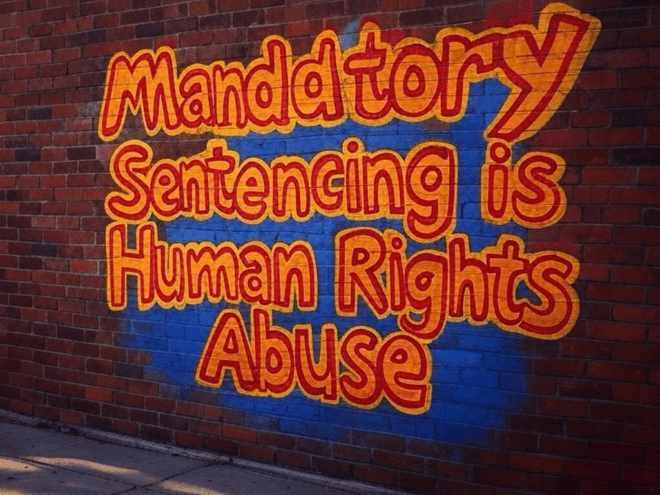
Abstract
Mandatory sentencing laws remain a polarising issue within the criminal justice system. Supporters argue these laws reflect societal values, ensure uniformity, prevent undue judicial leniency, and help deter crime. Conversely, numerous studies and expert analyses dispute these claims, highlighting how mandatory sentencing often results in severe injustices, disproportionately targets marginalised communities, complicates judicial processes, and imposes significant social and economic burdens. This study delves into both perspectives, ultimately advocating for a reassessment of mandatory sentencing policies in light of their far-reaching consequences for justice and society.
Introduction
Mandatory sentencing has seen widespread adoption in various regions, including Australia, where legal experts, human rights bodies, and the United Nations have scrutinised its impact. These laws require courts to apply fixed minimum sentences for certain offences, effectively removing judicial discretion. Advocates of mandatory sentencing claim it promotes public safety and fairness by standardising penalties. However, critics argue that such laws foster significant injustices, particularly for vulnerable populations, undermining the foundational principles of justice they intend to uphold.
Points Against Mandatory Sentencing
Disproportionate Punishments
One of the foremost criticisms of mandatory sentencing is its tendency to impose penalties that far exceed the severity of the offence. For example, minor drug-related offences often result in lengthy prison terms under these laws, whereas more serious crimes may receive comparatively lighter sentences. This imbalance in punishment disproportionately harms offenders—particularly those from underserved communities—aggravating their systemic disadvantages. Studies have shown that individuals convicted of minor drug offences can receive sentences longer than those for violent crimes, which raises questions about the fairness of such policies (Tonry, 1996).
Unequal Impact on Marginalised Groups
Certain social groups, especially Indigenous communities and individuals from lower socioeconomic backgrounds, bear the brunt of mandatory sentencing laws. Evidence reveals that these groups are already overrepresented in the criminal justice system. By disproportionately targeting offenses such as drug-related crimes, mandatory sentencing exacerbates existing inequities, fuelling cycles of poverty and exclusion. For instance, research by the Australian Institute of Criminology indicates that Indigenous Australians are more likely to receive harsher sentences than their non-Indigenous counterparts for similar offences (AIC, 2018).
Shift in Judicial Discretion
Mandatory sentencing transfers power from judges to prosecutors and law enforcement, leading to a more punitive framework. This redistribution of authority can allow prosecution and policing decisions to heavily influence sentencing outcomes, increasing the risk of misuse or abuse of power. Critics argue this erodes the integrity of the justice system by prioritising punishment over nuanced, individualised considerations. A report by the Sentencing Project highlights how mandatory sentencing can lead to prosecutorial overreach, where the choice of charges can drastically alter the outcome of a case (The Sentencing Project, 2015).
Increased Burden on Courts
The inflexible nature of mandatory sentencing often prompts defendants to contest charges they perceive as unfair, resulting in a rise in case backlogs. This, in turn, extends trial wait times, intensifies stress on court resources, and overwhelms legal aid services. Ultimately, this inefficiency hampers the effective operation of the justice system. A study by the National Center for State Courts found that mandatory minimums contribute to increased trial delays, further burdening an already strained judicial system (NCSC, 2017).
Threat to Natural Justice
Mandatory sentencing can undermine fundamental principles of fairness, particularly through its influence on plea bargains. Defendants may feel coerced into pleading guilty to avoid harsh mandatory penalties, even when valid defenses exist. Such scenarios compromise the integrity of the legal process, potentially leading to wrongful convictions. Research shows that in jurisdictions with mandatory sentencing, the rate of guilty pleas increases, often at the expense of justice (Bowers, 2017).
Limited Deterrence Effect
The claim that mandatory sentencing deters crime is widely contested. Research consistently shows that the likelihood of being caught, rather than the severity of penalties, serves as the primary deterrent to criminal behavior. A meta-analysis by the National Institute of Justice found no significant evidence that mandatory minimum sentences lead to reduced crime rates (NIJ, 2016). As a result, mandatory sentencing often fails to deliver the lower crime rates its proponents promise.
Economic Costs
The financial strain of incarceration is substantial—for both governments and society at large. Housing inmates, providing healthcare, and maintaining prison systems demand enormous taxpayer resources. Over time, the economic toll—compounded by diminished productivity and higher recidivism—outweighs any potential benefits of mandatory sentencing policies. According to the Vera Institute of Justice, the cost of incarceration in the U.S. exceeds $80 billion annually, a figure that continues to rise (Vera Institute, 2020).
Lack of Evidence for Crime Reduction
Despite assertions that mandatory sentencing curbs criminal activity, research provides little support for this claim. Studies consistently reveal no significant correlation between harsher penalties and lower crime rates. Regions that have enacted such laws have not experienced notable reductions in crime, raising questions about their effectiveness. For instance, a comprehensive review by the Urban Institute found that states with mandatory sentencing laws did not see a corresponding decrease in violent crime (Urban Institute, 2017).
Neglecting Victims’ Needs
Critics argue that mandatory sentencing prioritises punitive measures over measures that benefit victims. The focus on incarceration often sidelines restorative justice practices, which aim to support victims and rebuild communities. This punitive approach fosters cycles of vengeance instead of meaningful resolution and reparation for affected individuals. Restorative justice programs have shown success in addressing victim needs and reducing recidivism, yet they remain underutilised in mandatory sentencing frameworks (Zehr, 2015).
Alternative Approaches
Cost-effective and impactful alternatives to mandatory sentencing are readily available. Community-based sanctions, rehabilitation programs, diversion initiatives, and restorative justice strategies have shown promising results in addressing the root causes of crime and reducing recidivism. These solutions not only save money but also provide better long-term outcomes for both offenders and society. For instance, programs focusing on rehabilitation rather than incarceration have been shown to reduce recidivism rates significantly (Mackenzie, 2006).
Points in Favor of Mandatory Sentencing
Alignment with Public Values
Proponents argue that mandatory sentencing aligns with societal expectations surrounding justice. By mandating consistent penalties for particular crimes, these laws offer assurance that offenders will face uniform consequences, thus boosting public confidence in the legal system. Surveys have indicated that many citizens support the idea of predictable consequences for criminal behavior, viewing it as a means to ensure fairness (Pew Research Center, 2018).
Consistency in Punishments
Mandatory sentencing aims to eliminate inconsistencies in judicial outcomes by standardising penalties. Supporters contend this consistency strengthens the legal system’s credibility and ensures offenders are held accountable without room for undue leniency. They argue that this uniformity helps prevent situations where similar offences receive wildly different sentences, thus promoting a sense of fairness in the eyes of the public.
Reduction of Judicial Leniency
Advocates believe mandatory sentencing counteracts judicial leniency, addressing public concerns about excessively light penalties for serious offences. By instituting fixed sentencing guidelines, these laws ensure crimes are met with penalties reflective of their gravity. Proponents argue that this approach helps restore public trust in the justice system, which they believe has been undermined by perceived leniency.
Potential Crime Deterrence
Some supporters suggest that the predictable nature of mandatory penalties can discourage criminal behaviour. Clear-cut consequences for specific offenses, they argue, may deter would-be offenders from engaging in illegal activity. They assert that the certainty of punishment, rather than its severity, is what truly deters crime, aligning with theories of deterrence in criminology.
Public Opinion and Research Trends
Recent studies, including those by the Queensland Law Reform Commission, indicate a growing preference among the public for sentencing flexibility over rigid mandatory laws. Many citizens favor individualised considerations that reflect the circumstances of each case. Additionally, research shows the majority of jurors prefer judicial discretion, suggesting that public opinion may not fully support the stringent framework of mandatory sentencing. This shift in public sentiment indicates a potential movement toward more rehabilitative and restorative approaches to justice (QLRC, 2020).
Conclusion
The debate over mandatory sentencing is complex, with compelling arguments on both sides. However, the overwhelming evidence underscores how these policies cause significant injustices, disproportionately affect marginalised populations, strain judicial resources, and fail to achieve their intended goals. A thorough re-evaluation of mandatory sentencing laws is essential to align justice policies with fairness, equity, and societal well-being. It is imperative that policymakers consider alternative approaches that prioritise rehabilitation and restorative justice, ultimately fostering a more equitable and effective criminal justice system.
References
1. Australian Institute of Criminology (AIC). (2018). Indigenous Australians and the Criminal Justice System.
2. Bowers, J. (2017). The Impact of Mandatory Sentencing on Plea Bargaining. Criminal Justice Review.
3. Mackenzie, D. L. (2006). What Works in Corrections: Reducing the Criminal Activities of Offenders and Delinquents. Cambridge University Press.
4. National Center for State Courts (NCSC). (2017). The Impact of Mandatory Sentencing on Court Resources.
5. National Institute of Justice (NIJ). (2016). The Effectiveness of Mandatory Minimum Sentences.
6. Pew Research Center. (2018). Public Opinion on Crime and Punishment.
7. Queensland Law Reform Commission (QLRC). (2020). Sentencing Advisory Council: Public Attitudes to Sentencing.
8. Sentencing Project. (2015). The Impact of Mandatory Minimum Sentences on the Justice System.
9. Urban Institute. (2017). The Effects of Mandatory Sentencing on Crime Rates.
10. Vera Institute of Justice. (2020). The Price of Prisons: What Incarceration Costs Taxpayers.
11. Tonry, M. (1996). Sentencing Matters. Oxford University Press.
12. Zehr, H. (2015). The Little Book of Restorative Justice. Good Books.



Are there not already sentencing guidelines for convictions? Mandatory sentencing such as that which was legislated this week in Australia sets unreasonably high custodial sentences compared with other much more serious convictions. It’s not balanced.